formerly eScholarship Editions


|
|
|
|
Your request for similar items found 20 book(s). | Modify Search | Displaying 1 - 20 of 20 book(s) | |
| 1. | 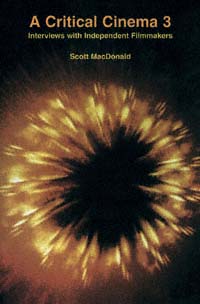 | Title: A critical cinema 3: interviews with independent filmmakers Author: MacDonald, Scott 1942- Published: University of California Press, 1998 Subjects: Cinema and Performance Arts | Film Publisher's Description: A Critical Cinema 3 continues Scott MacDonald's compilation of personal interviews and public discussions with major contributors to independent filmmaking and film awareness. An informative exchange with Amos Vogel, whose Cinema 16 Society drew American filmgoers into a broader sense of film history, is followed by interviews reflecting a wide range of approaches to filmmaking. Sally Potter discusses her popular feature, Orlando , in relation to the experimental work that preceded it, and Canadian independent John Porter argues compellingly for small-gauge, Super-8mm filmmaking. Ken Jacobs discusses the "Nervous System" apparatus with which he transforms old film footage into new forms of motion picture art; Jordan Belson describes his Vortex Concerts, ancestors of modern laser light shows; and Elias Merhige talks about going beneath the "rational structure of meaning" in Begotten . A Critical Cinema 3 presents independent cinema as an international and multiethnic phenomenon. MacDonald interviews filmmakers from Sweden, France, Italy, Austria, Armenia, India, the Philippines, and Japan and examines the work of African Americans, European Americans, Asian Americans, and Hispanics. He provides an introductory overview of each interviewee, as well as detailed film/videographies and selected bibliographies. With its predecessors, A Critical Cinema (California, 1988) and A Critical Cinema 2 (California, 1992), this is the most extensive, in-depth exploration of independent cinema available in English. [brief] Similar Items |
| 2. | 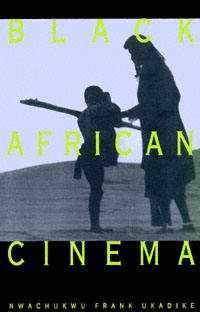 | Title: Black African cinema Author: Ukadike, Nwachukwu Frank Published: University of California Press, 1994 Subjects: Cinema and Performance Arts | Film Publisher's Description: From the proselytizing lantern slides of early Christian missionaries to contemporary films that look at Africa through an African lens, N. Frank Ukadike explores the development of black African cinema. He examines the impact of culture and history, and of technology and co-production, on filmmaking throughout Africa.Every aspect of African contact with and contribution to cinematic practices receives attention: British colonial cinema; the thematic and stylistic diversity of the pioneering "francophone" films; the effects of television on the motion picture industry; and patterns of television documentary filmmaking in "anglophone" regions. Ukadike gives special attention to the growth of independent production in Ghana and Nigeria, the unique Yoruba theater-film tradition, and the militant liberationist tendencies of "lusophone" filmmakers. He offers a lucid discussion of oral tradition as a creative matrix and the relationship between cinema and other forms of popular culture. And, by contrasting "new" African films with those based on the traditional paradigm, he explores the trends emerging from the eighties and nineties.Clearly written and accessible to specialist and general reader alike, Black African Cinema 's analysis of key films and issues - the most comprehensive in English - is unique. The book's pan-Africanist vision heralds important new strategies for appraising a cinema that increasingly attracts the attention of film students and Africanists. [brief] Similar Items |
| 3. | 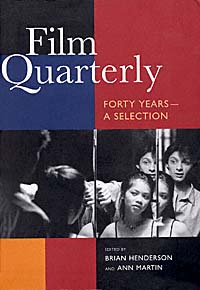 | Title: Film quarterly: forty years--a selection Author: Henderson, Brian Published: University of California Press, 1999 Subjects: Cinema and Performance Arts | Film Publisher's Description: During its forty years as a forum for scholars, filmmakers, critics, and film lovers, Film Quarterly has looked in depth at the most critical elements in the political, social, theoretical, and aesthetic history of the cinema. Once closely tied to Hollywood, the journal was investigated by the Tenney committee in 1946 and two of its board members came under fire from the House Un-American Activities Committee in 1951. After several metamorphoses, however, and with the dedicated participation of its editors, board members, and authors, the journal now stands as the oldest and most prominent journal in cinema studies, publishing film (and video and television) history, criticism, theory, analysis, interviews, and film and book reviews.Spanning the 1950s to the 1990s, Film Quarterly: Forty Years - A Selection is a collaborative effort by the past and present editors and the editorial board to celebrate and illuminate the medium that has prompted so much thought and exchange during the journal's lifetime. From articles on documentary and genre to history and technology, narrative and the avant-garde, this carefully selected collection proposes groundbreaking theoretical models, fresh approaches to individual film classics, reassessments of filmmakers' bodies of work, and discussions of new films and technologies. [brief] Similar Items |
| 4. | 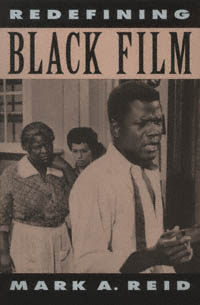 | Title: Redefining Black film Author: Reid, Mark (Mark A.) Published: University of California Press, 1993 Subjects: Cinema and Performance Arts | Film | African American Studies Publisher's Description: Can films about black characters, produced by white filmmakers, be considered "black films"? In answering this question, Mark Reid reassesses black film history, carefully distinguishing between films controlled by blacks and films that utilize black talent, but are controlled by whites. Previous black film criticism has "buried" the true black film industry, Reid says, by concentrating on films that are about, but not by, blacks.Reid's discussion of black independent films - defined as films that focus on the black community and that are written, directed, produced, and distributed by blacks - ranges from the earliest black involvement at the turn of the century up through the civil rights movement of the Sixties and the recent resurgence of feminism in black cultural production. His critical assessment of work by some black filmmakers such as Spike Lee notes how these films avoid dramatizations of sexism, homophobia, and classism within the black community.In the area of black commercial film controlled by whites, Reid considers three genres: African-American comedy, black family film, and black action film. He points out that even when these films use black writers and directors, a black perspective rarely surfaces.Reid's innovative critical approach, which transcends the "black-image" language of earlier studies - and at the same time redefines black film - makes an important contribution to film history. Certain to attract film scholars, this work will also appeal to anyone interested in African-American and Women's Studies. [brief] Similar Items |
| 5. | 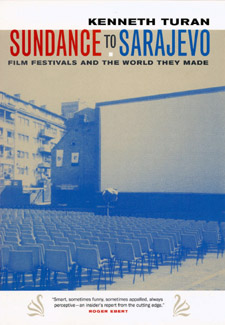 | Title: Sundance to Sarajevo: film festivals and the world they made Author: Turan, Kenneth Published: University of California Press, 2002 Subjects: Cinema and Performance Arts | Film Publisher's Description: Almost every day of the year a film festival takes place somewhere in the world--from sub-Saharan Africa to the Land of the Midnight Sun. Sundance to Sarajevo is a tour of the world's film festivals by an insider whose familiarity with the personalities, places, and culture surrounding the cinema makes him uniquely suited to his role. Kenneth Turan, film critic for the Los Angeles Times, writes about the most unusual as well as the most important film festivals, and the cities in which they occur, with an eye toward the larger picture. His lively narrative emphasizes the cultural, political, and sociological aspects of each event as well as the human stories that influence the various and telling ways the film world and the real world intersect. Of the festivals profiled in detail, Cannes and Sundance are obvious choices as the biggest, brashest, and most influential of the bunch. The others were selected for their ability to open a window onto a wider, more diverse world and cinema's place in it. Sometimes, as with Sarajevo and Havana, film is a vehicle for understanding the international political community's most vexing dilemmas. Sometimes, as with Burkina Faso's FESPACO and Pordenone's Giornate del Cinema Muto, it's a chance to examine the very nature of the cinematic experience. But always the stories in this book show us that film means more and touches deeper chords than anyone might have expected. No other book explores so many different festivals in such detail or provides a context beyond the merely cinematic. [brief] Similar Items |
| 6. | 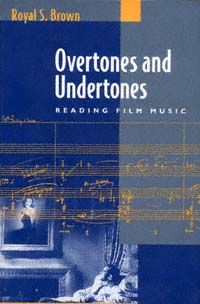 | Title: Overtones and undertones: reading film music Author: Brown, Royal S Published: University of California Press, 1994 Subjects: Cinema and Performance Arts | Film | Music Publisher's Description: Since the days of silent films, music has been integral to the cinematic experience, serving, variously, to allay audiences' fears of the dark and to heighten a film's emotional impact. Yet viewers are often unaware of its presence. In this bold, insightful book, film and music scholar and critic Royal S. Brown invites readers not only to "hear" the film score, but to understand it in relation to what they "see."Unlike earlier books, which offered historical, technical, and sociopolitical analyses, Overtones and Undertones draws on film, music, and narrative theory to provide the first comprehensive aesthetics of film music. Focusing on how the film/score interaction influences our response to cinematic situations, Brown traces the history of film music from its beginnings, covering both American and European cinema. At the heart of his book are close readings of several of the best film/score interactions, including Psycho, Laura, The Sea Hawk, Double Indemnity, and Pierrot le Fou. In revealing interviews with Bernard Herrmann, Miklós Rósza, Henry Mancini, and others, Brown also allows the composers to speak for themselves. A complete discography and bibliography conclude the volume. [brief] Similar Items |
| 7. | 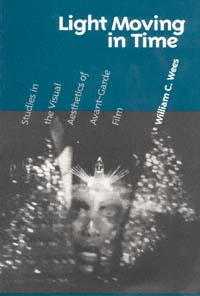 | Title: Light moving in time: studies in the visual aesthetics of avant-garde film Author: Wees, William C. (William Charles) 1935- Published: University of California Press, 1992 Subjects: Cinema and Performance Arts | Film Publisher's Description: To view a film is to see another's seeing mediated by the technology and techniques of the camera. By manipulating the cinematic apparatus in unorthodox ways, avant-garde filmmakers challenge the standardized versions of seeing perpetuated by the dominant film industry and generate ways of seeing that are truer to actual human vision.Beginning with the proposition that the images of cinema and vision derive from the same basic elements - light, movement, and time - Wees argues that cinematic apparatus and human visual apparatus have significant properties in common. For that reason they can be brought into a dynamic, creative relationship which the author calls the dialectic of eye and camera. The consequences of this relationship are what Wees explores.Although previous studies have recognized the visual bias of avant-garde film, this is the first to place the visual aesthetics of avant-garde film in a long-standing, multidisciplinary discourse on vision, visuality, and art. [brief] Similar Items |
| 8. | 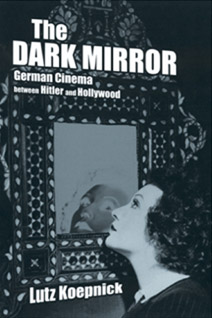 | Title: The dark mirror: German cinema between Hitler and Hollywood Author: Koepnick, Lutz P. (Lutz Peter) Published: University of California Press, 2002 Subjects: Cinema and Performance Arts | German Studies | Music | Film Publisher's Description: Lutz Koepnick analyzes the complicated relationship between two cinemas - Hollywood's and Nazi Germany's - in this theoretically and politically incisive study. The Dark Mirror examines the split course of German popular film from the early 1930s until the mid 1950s, showing how Nazi filmmakers appropriated Hollywood conventions and how German film exiles reworked German cultural material in their efforts to find a working base in the Hollywood studio system. Through detailed readings of specific films, Koepnick provides a vivid sense of the give and take between German and American cinema. [brief] Similar Items |
| 9. | 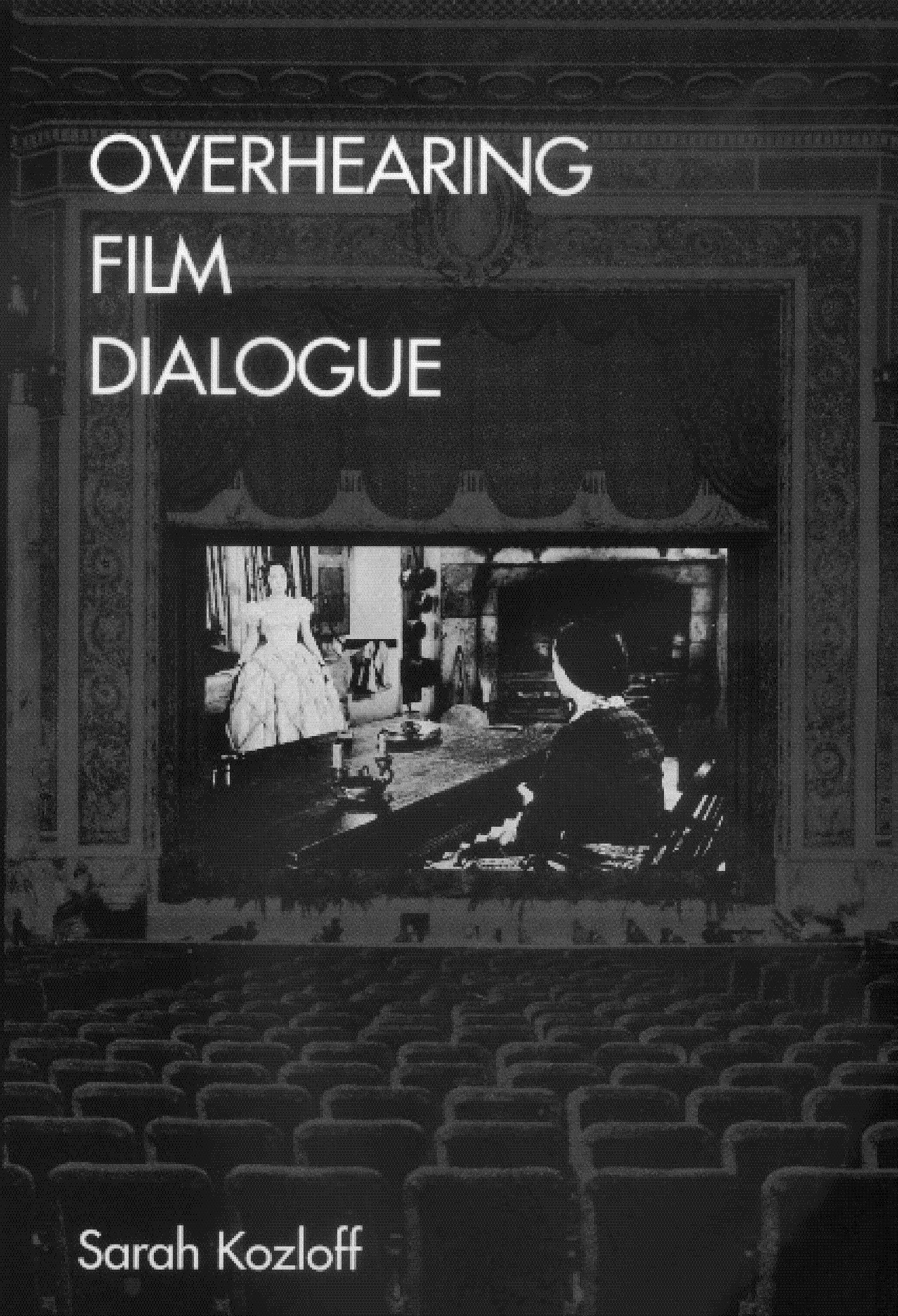 | Title: Overhearing film dialogue Author: Kozloff, Sarah Published: University of California Press, 2000 Subjects: Cinema and Performance Arts | Literary Theory and Criticism | American Studies | Film Publisher's Description: Since the birth of cinema, film has been lauded as a visual rather than a verbal medium; this sentiment was epitomized by John Ford's assertion in 1964 that, "When a motion picture is at its best, it is long on action and short on dialogue." Little serious work has been done on the subject of film dialogue, yet what characters say and how they say it has been crucial to our experience and understanding of every film since the coming of sound. Through informative discussions of dozens of classic and contemporary films - from Bringing Up Baby to Terms of Endearment, from Stagecoach to Reservoir Dogs --this lively book provides the first full-length study of the use of dialogue in American film. Sarah Kozloff shows why dialogue has been neglected in the analysis of narrative film and uncovers the essential contributions dialogue makes to a film's development and impact. She uses narrative theory and drama theory to analyze the functions that dialogue typically serves in a film. The second part of the book is a comprehensive discussion of the role and nature of dialogue in four film genres: westerns, screwball comedies, gangster films, and melodramas. Focusing on topics such as class and ethnic dialects, censorship, and the effect of dramatic irony, Kozloff provides an illuminating new perspective on film genres. [brief] Similar Items |
| 10. | 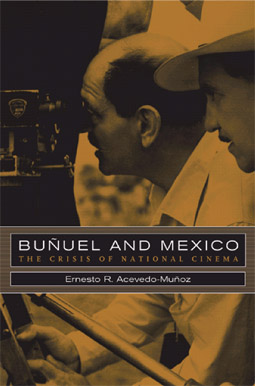 | Title: Buñuel and Mexico: the crisis of national cinema Author: Acevedo-Muñoz, Ernesto R 1968- Published: University of California Press, 2003 Subjects: Cinema and Performance Arts | Latin American History | Latin American Studies Publisher's Description: Though Luis Buñuel, one of the most important filmmakers of the twentieth century, spent his most productive years as a director in Mexico, film histories and criticism invariably pay little attention to his work during this period. The only English-language study of Buñuel's Mexican films, this book is the first to explore a significant but neglected area of this filmmaker's distinguished career and thus to fill a gap in our appreciation and understanding of both Buñuel's achievement and the history of Mexican film. Ernesto Acevedo-Muñoz considers Buñuel's Mexican films - made between 1947 and 1965 - within the context of a national and nationalist film industry, comparing the filmmaker's employment of styles, genres, character types, themes, and techniques to those most characteristic of Mexican cinema. In this study Buñuel's films emerge as a link between the Classical Mexican cinema of the 1930s through the 1950s and the "new" Cinema of the 1960s, flourishing in a time of crisis for the national film industry and introducing some of the stylistic and conceptual changes that would revitalize Mexican cinema. [brief] Similar Items |
| 11. | 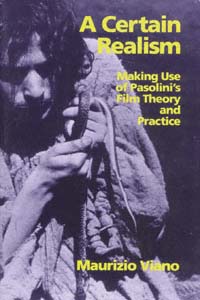 | Title: A certain realism: making use of Pasolini's film theory and practice Author: Viano, Maurizio Sanzio 1950- Published: University of California Press, 1993 Subjects: Cinema and Performance Arts | Film Publisher's Description: Pier Paolo Pasolini (1922-1975) was arguably the most complex director of postwar Italian cinema. His films - Accattone , The Canterbury Tales , Medea , Saló - continue to challenge and entertain new generations of moviegoers. A leftist, a homosexual, and a distinguished writer of fiction, poetry, and criticism, Pasolini once claimed that "a certain realism" informed his filmmaking.Masterfully combining analyses of Pasolini's literary and theoretical writings and of all his films, Maurizio Viano offers the first thorough study of Pasolini's cinematic realism, in theory and in practice. He finds that Pasolini's cinematic career exemplifies an "expressionistic realism" that acknowledges its subjective foundation instead of striving for an impossible objectivity.Focusing on the personal and expressionistic dimensions of Pasolini's cinema, Viano also argues that homosexuality is present in the films in ways that critics have thus far failed to acknowledge. Sure to generate controversy among film scholars, Italianists, and fans of the director's work, this accessible film-by-film treatment is an ideal companion for anyone watching Pasolini's films on video. [brief] Similar Items |
| 12. | 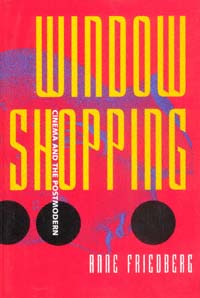 | Title: Window shopping: cinema and the postmodern Author: Friedberg, Anne Published: University of California Press, 1993 Subjects: Cinema and Performance Arts | Film | Popular Culture | Women's Studies Publisher's Description: Departing from those who define postmodernism in film merely as a visual style or set of narrative conventions, Anne Friedberg develops the first sustained account of the cinema's role in postmodern culture. She explores the ways in which nineteenth-century visual experiences - photography, urban strolling, panorama and diorama entertainments - anticipate contemporary pleasures provided by cinema, video, shopping malls, and emerging "virtual reality" technologies.Comparing the visual practices of shopping, tourism, and film-viewing, Friedberg identifies the experience of "virtual" mobility through time and space as a key determinant of postmodern cultural identity. Evaluating the theories of Jameson, Lyotard, Baudrillard, and others, she adds critical insights about the role of gender and gender mobility in the configurations of consumer culture.A strikingly original work, Window Shopping challenges many of the existing assumptions about what exactly post modern is. This book marks the emergence of a compelling new voice in the study of contemporary culture. [brief] Similar Items |
| 13. | 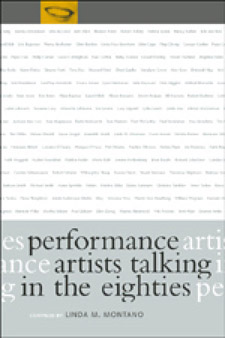 | Title: Performance artists talking in the eighties: sex, food, money/fame, ritual/death Author: Montano, Linda 1942- Published: University of California Press, 2001 Subjects: Art | Art History | Cinema and Performance Arts Publisher's Description: Performance artist Linda Montano, curious about the influence childhood experience has on adult work, invited other performance artists to consider how early events associated with sex, food, money/fame, or death/ritual resurfaced in their later work. The result is an original and compelling talking performance that documents the production of art in an important and often misunderstood community. Among the more than 100 artists Montano interviewed from 1979 to 1989 were John Cage, Suzanne Lacy, Faith Ringgold, Dick Higgins, Annie Sprinkle, Allan Kaprow, Meredith Monk, Eric Bogosian, Adrian Piper, Karen Finley, and Kim Jones. Her discussions with them focused on the relationship between art and life, history and memory, the individual and society, and the potential for individual and social change. The interviews highlight complex issues in performance art, including the role of identity in performer-audience relationships and art as an exploration of everyday conventions rather than a demonstration of virtuosity. [brief] Similar Items |
| 14. | 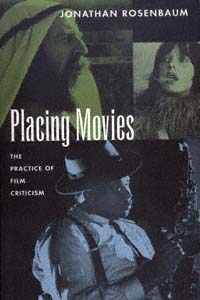 | Title: Placing movies: the practice of film criticism Author: Rosenbaum, Jonathan Published: University of California Press, 1995 Subjects: Cinema and Performance Arts | Film Publisher's Description: Jonathan Rosenbaum, longtime contributor to such publications as Film Quarterly, Sight and Sound, and The Village Voice , is arguably the most eloquent, insightful film critic writing in America today. Placing Movies , the first collection of his work, gathers together thirty of his most distinctive and illuminating pieces. Written over a span of twenty-one years, these essays cover an extraordinarily broad range of films - from Hollywood blockbusters to foreign art movies to experimental cinema. They include not just reviews but perceptive commentary on directors, actors, and trends; and thoughtful analysis of the practice of film criticism.It is this last element - Rosenbaum's reflections on the art of film criticism - that sets this collection apart from other volumes of film writing. Both in the essays themselves and in the section introductions, Rosenbaum provides a rare insider's view of his profession: the backstage politics, the formulation of critical judgments, the function of film commentary. Taken together, these pieces serve as a guided tour of the profession of film criticism.They also serve as representative samples of Rosenbaum's unique brand of film writing. Among the highlights are memoirs of director Jacques Tati and maverick critic Manny Farber, celebrations of classics such as Gentlemen Prefer Blondes and The Manchurian Candidate , and considered reevaluations of Orson Welles and Woody Allen. [brief] Similar Items |
| 15. |  | Title: Comedy/cinema/theory Author: Horton, Andrew Published: University of California Press, 1991 Subjects: Cinema and Performance Arts | Film Publisher's Description: The nature of comedy has interested many thinkers, from Plato to Freud, but film comedy has not received much theoretical attention in recent years. The essays in Comedy/Cinema/Theory use a range of critical and theoretical approaches to explore this curious and fascinating subject. The result is a stimulating, informative book for anyone interested in film, humor, and the art of bringing the two together.Comedy remains a central human preoccupation, despite the vagaries in form that it has assumed over the centuries in different media. In his introduction, Horton surveys the history of the study of comedy, from Aristophanes to the present, and he also offers a perspective on other related comic forms: printed fiction, comic books, TV sitcoms, jokes and gags.Some essays in the collection focus on general issues concerning comedy and cinema. In lively (and often humorous) prose, such scholars as Lucy Fischer, Noel Carroll, Peter Lehman, and Brian Henderson employ feminist, post-Freudian, neo-Marxist, and Bakhtinian methodologies. The remaining essays bring theoretical considerations to bear on specific works and comic filmmakers. Peter Brunette, William Paul, Scott Bukatman, Dana Polan, Charles Eidsvik, Ruth Perlmutter, Stephen Mamber, and Andrew Horton provide different perspectives for analyzing The Three Stooges, Chaplin, Jerry Lewis, Woody Allen, Dusan Makavejev, and Alfred Hitchcock's sole comedy, Mr. and Mrs. Smith , as well as the peculiar genre of cynical humor from Eastern Europe.As editor Horton notes, an over-arching theory of film comedy does not emanate from these essays. Yet the diversity and originality of the contributions reflect vital and growing interest in the subject, and both students of film and general moviegoers will relish the results. [brief] Similar Items |
| 16. | 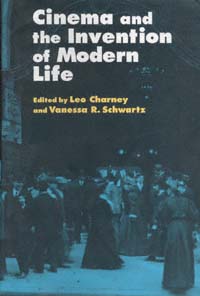 | Title: Cinema and the invention of modern life Author: Charney, Leo Published: University of California Press, 1996 Subjects: Cinema and Performance Arts | Film | Intellectual History | Popular Culture Publisher's Description: Casting aside the traditional conception of film as an outgrowth of photography, theater, and the novel, the essays in this volume reassess the relationship between the emergence of film and the broader culture of modernity. Contributors, leading scholars in film and cultural studies, link the popul . . . [more] Similar Items |
| 17. | 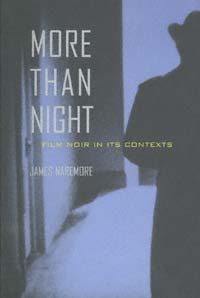 | Title: More than night: film noir in its contexts Author: Naremore, James Published: University of California Press, 1998 Subjects: Cinema and Performance Arts | Film | Literature Publisher's Description: "Film noir" evokes memories of stylish, cynical, black-and-white movies from the 1940s and 1950s - melodramas about private eyes, femmes fatales, criminal gangs, and lovers on the run. In More Than Night , James Naremore discusses these pictures, but he also shows that the central term is more complex and paradoxical than we realize. Film noir refers both to an important cinematic legacy and to an idea we have projected onto the past.This lively, wide-ranging cultural history offers an original approach to the subject, as well as new production information and fresh commentary on scores of films, including such classics as Double Indemnity , The Third Man , and Out of the Past , and such "neo noirs" as Chinatown , Pulp Fiction , and Devil in a Blue Dress . Naremore discusses film noir as a term in criticism; as an expression of artistic modernism; as a symptom of Hollywood censorship and politics in the 1940s; as a market strategy; as an evolving style; as a cinema about races and nationalities; and as an idea that circulates across all the information technologies. Interdisciplinary in approach, this book has valuable things to say not only about film and television, but also about modern literature, the fine arts, and popular culture in general. In a field where much of what has been published is superficial and derivative, Naremore's work is certain to be received as a definitive treatment. [brief] Similar Items |
| 18. | 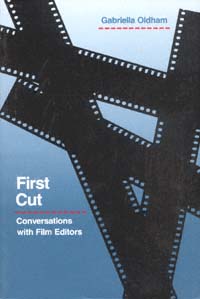 | Title: First cut: conversations with film editors Author: Oldham, Gabriella Published: University of California Press, 1992 Subjects: Cinema and Performance Arts | Film | Media Studies Publisher's Description: First Cut offers an opportunity to learn what film editing really is, and to learn from the source. Gabriella Oldham's interviews with twenty-three award-winning film editors give a full picture of the complex art and craft of editing a film. Filled with animated anecdotes and detailed examples, thi . . . [more] Similar Items |
| 19. | 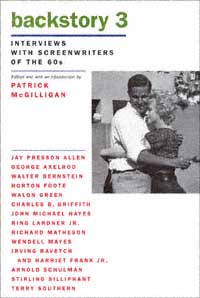 | Title: Backstory 3: interviews with screenwriters of the 1960s Author: McGilligan, Patrick Published: University of California Press, 1997 Subjects: Cinema and Performance Arts | Film | Writing Publisher's Description: The Backstory series of unique "oral histories" chronicles the lives and careers of notable Hollywood screenwriters - in their own words. Backstory: Interviews with Screenwriters of Hollywood's Golden Age focused on the early sound era and the 1930s. Backstory 2 featured Interviews with Screenwriters of the 1940s and 1950s. Backstory 3 takes up the history of American screenwriting in the 1960s, through the experiences of fourteen key scenarists. These lively interviews, conducted by Pat McGilligan and others, feature Jay Presson Allen, George Axelrod, Walter Bernstein, Horton Foote, Walon Green, Charles B. Griffith, John Michael Hayes, Ring Lardner Jr., Wendell Mayes, Irving Ravetch and Harriet Frank Jr., Arnold Schulman, Stirling Silliphant, and Terry Southern.The series has proven useful and edifying for film students, scholars, and historians, for screenwriters and other professionals, and for film buffs in general. Applauded by reviewers and named among the "100 essential film books" by a Los Angeles Times -appointed panel, it is cited often and quoted in many film histories. [brief] Similar Items |
| 20. | 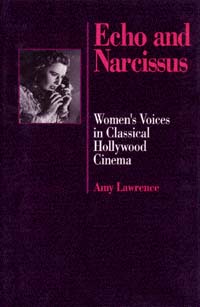 | Title: Echo and Narcissus: women's voices in classical Hollywood cinema Author: Lawrence, Amy Published: University of California Press, 1991 Subjects: Cinema and Performance Arts | Film | Women's Studies Publisher's Description: Do women in classical Hollywood cinema ever truly speak for themselves? In Echo and Narcissus , Amy Lawrence examines eight classic films to show how women's speech is repeatedly constructed as a "problem," an affront to male authority. This book expands feminist studies of the representation of women in film, enabling us to see individual films in new ways, and to ask new questions of other films.Using Sadie Thompson (1928), Blackmail (1929), Rain (1932), The Spiral Staircase , Sorry,Wrong Number , Notorious , Sunset Boulevard (1950) and To Kill a Mockingbird (1962), Lawrence illustrates how women's voices are positioned within narratives that require their submission to patriarchal roles and how their attempts to speak provoke increasingly severe repression. She also shows how women's natural ability to speak is interrupted, made difficult, or conditioned to a suffocating degree by sound technology itself. Telephones, phonographs, voice-overs, and dubbing are foregrounded, called upon to silence women and to restore the primacy of the image.Unlike the usage of "voice" by feminist and literary critics to discuss broad issues of authorship and point of view, in film studies the physical voice itself is a primary focus. Echo and Narcissus shows how assumptions about the "deficiencies" of women's voices and speech are embedded in sound's history, technology, uses, and marketing. Moreover, the construction of the woman's voice is inserted into the ideologically loaded cinematic and narrative conventions governing the representation of women in Hollywood film. [brief] Similar Items |